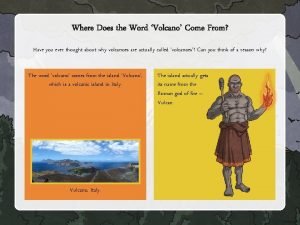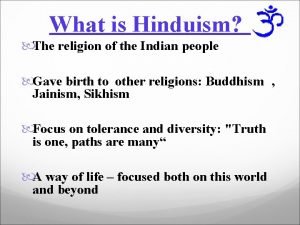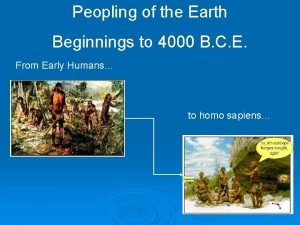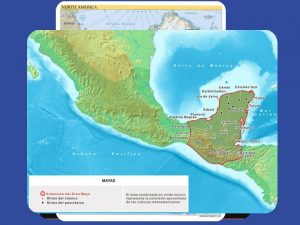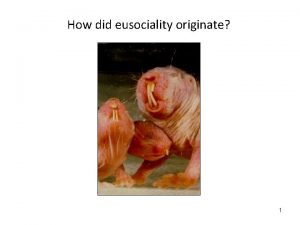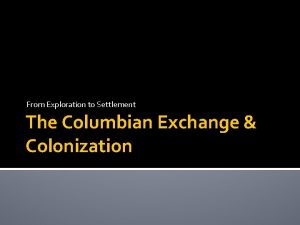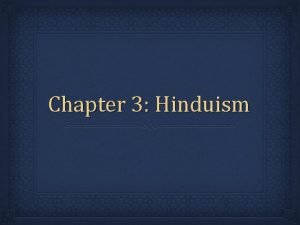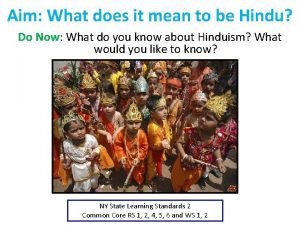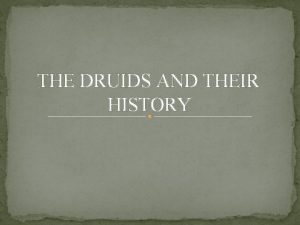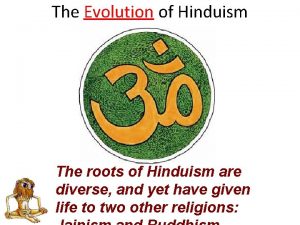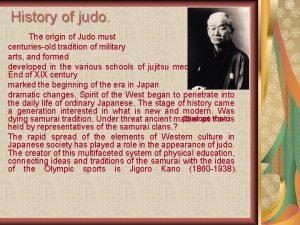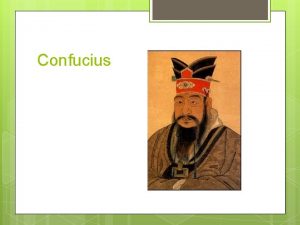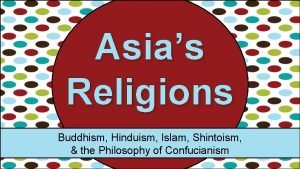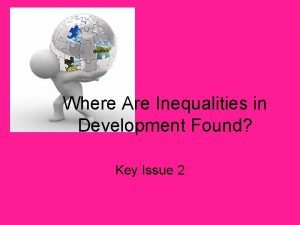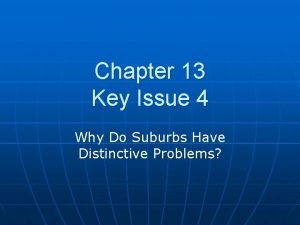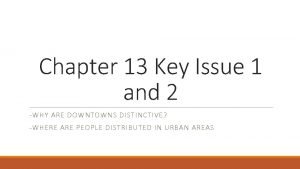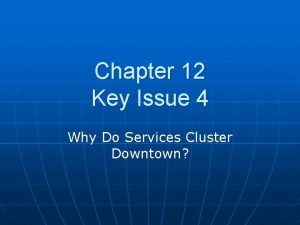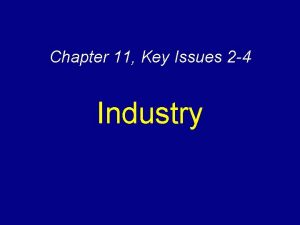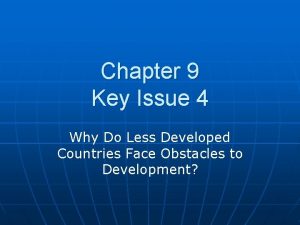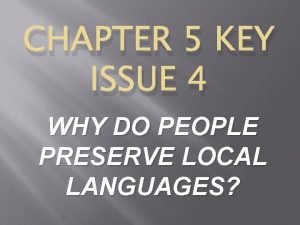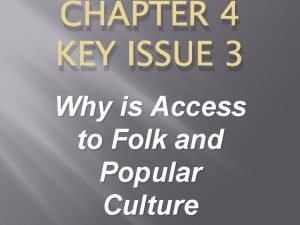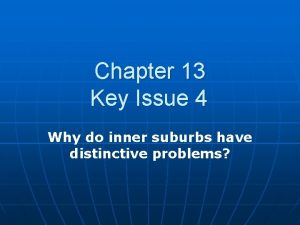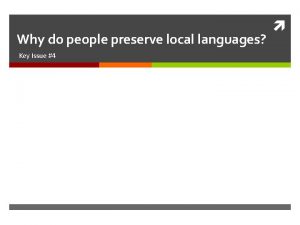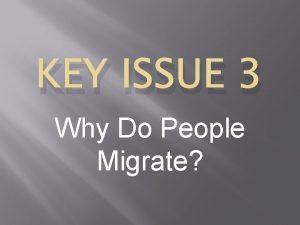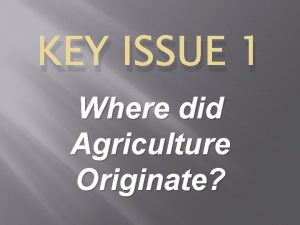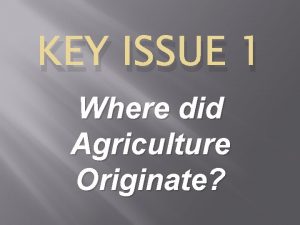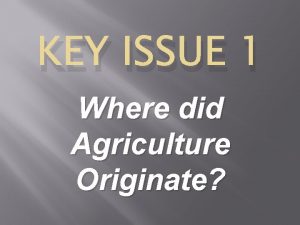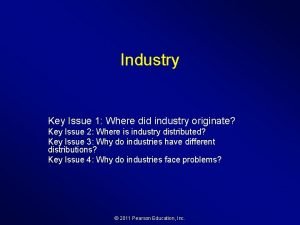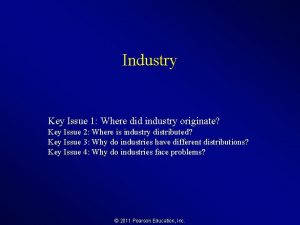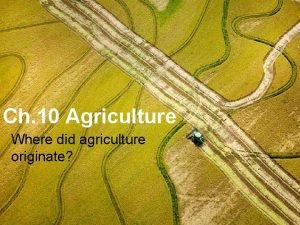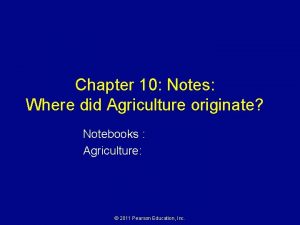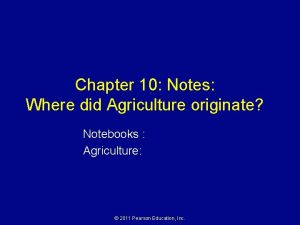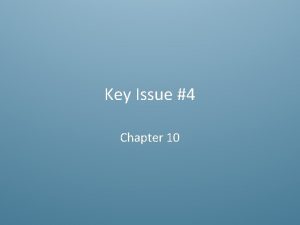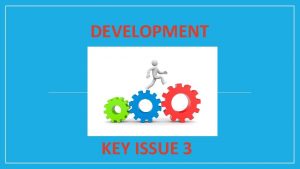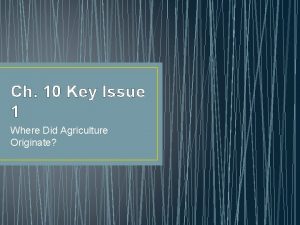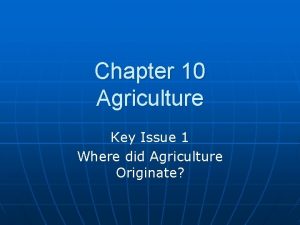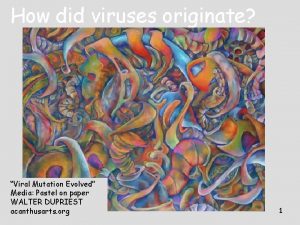Agriculture Key Issue 1 Where did Agriculture originate

























































- Slides: 57

Agriculture Key Issue 1: Where did Agriculture originate?

Origins of Agriculture �Invention of Agriculture � Prior to the advent of agriculture, all humans probably obtained needed food through hunting and gathering. � Origins of agriculture cannot be documented with certainty, because it began before recorded history. � Agriculture is deliberate modification of Earth’s surface through cultivation of plants and rearing of animals to obtain sustenance or economic gain

Hunting and Gathering �Hunting, fishing, gathering plants, etc. �Lived in small groups w/ usually fewer than 50 ppl �Men hunted game, women gathered berries, nuts, and roots �Traveled frequently � Depended on movement of game and seasonal growth of plants

Contemporary Hunting and Gathering �Today less than 0. 005% of the world’s population still survive by hunting and gathering �Live in isolated locations � Arctic � Interior of Africa � Australia � South America

Hunter-Gatherers �Humanity’s only “economic” activity for at least 90% of our existence. �Low population densities. �Wide variety of natural foodstuffs eaten. �What stage of the DTM? ? ?

Invention of Agriculture � Neolithic Revolution/1 st Agricultural Revolution � Domestication of plants/animals…. Mankind no longer soley dependent on hunting and gathering � Around 8000 B. C. � World’s population grew at more rapid rate than it had in past � Larger, more stable sources of food

Crop Hearths � Agriculture originated in multiple hearths around the world: �Crop Hearths: Southwest Asia: Early crops: barley, wheat, lentil, and olive. East Asia: Early crops: Rice and millet. Sub-Saharan Africa Sorghum, Yams, rice Latin America Beans, cotton, potato, MAIZE

Carl Sauer - Types of Cultivation �Vegetative Planting � Direct cloning of plants � Cutting stems and dividing roots � Originated in SE Asia – taro, yam, banana, palm � Diffused to China, Japan, India, SW Asia, and Africa �Seed Agriculture � Reproduction of plants through annual planting of seeds � Originated in Western India, northern China, Ethiopia � Western Hemisphere – Mexico and Northern Peru

Animal Hearths �Southwest Asia: � Early domesticated animals: Cattle, goats, pigs, sheep, and dogs. �Central Asia: � Early domesticated animals: Horses

Differences between Commercial and Subsistence Agriculture �Purpose of farming �% of farmers in the labor force �Use of machinery �Farm size �Relationship of farming to other business Subsistence Commercial Purpose of farming Survival Profit % of farmers Large Small Use of machinery Limited Extensive Farm size Small Large Relationship to other business None agribusiness




Types of Agriculture LDCs and MDCs

Types of Agriculture Found in LDCs

Subsistence Agriculture Regions

Shifting Cultivation Vegetation “slashed” and then burned. Soil remains fertile for 2 -3 years. Then people move on. · where: Less developed world. Amazon, Central and West Africa, Southeast Asia (Indochina, Indonesia, New Guinea) · crops: upland rice (S. E. Asia), maize and manioc (S. America), millet and sorghum (Africa) Declining at hands of ranching and logging.


Pastoral Nomadism The breeding and herding of domesticated animals for subsistence · where: arid and semi-arid areas of N. Bedouin Shepherd Somali Nomad and Tent Africa, Middle East, Central Asia · animals: Camel, Goats, Sheep, Cattle · transhumance: seasonal migrations from highlands to lowlands Most nomads are being pressured into sedentary life as land is usurped for agriculture or mining.


Intensive Subsistence Agriculture �Wet Rice Dominant · where: S. E. Asia, E. India, S. E. The Fields of Bali China · very labor intensive production of rice · most important source of food in Asia · grown on flat, or terraced land Double cropping is used in warm winter areas of S. China and Taiwan Thai Rice Farmers



Intensive Subsistence Agriculture Wet Rice Not Dominant · where: Central Asia and India, where it is too dry for wet rice · crops: wheat, barley, millet, oats, corn, soybeans · still very intensive use of land · crop rotation retains soil fertility and allows constant production Subsistence Farm, India

Plantation Farming �large scale mono-cropping of profitable products not able to be grown in Europe or U. S. �where: tropical lowland Periphery �crops: cotton, sugar cane, coffee, rubber, cocoa, bananas, tea, coconuts, palm oil.

Types of Agriculture Found in MDCs

Mixed Crop and Livestock Farming Where: Ohio to Dakotas, centered on Iowa; much of Europe from France to Russia · crops: corn (most common), soybeans · most product fed to pigs and cattle · Highly inefficient use of natural resources · Pounds of grain to make 1 lb. beef: 10 · Gallons of water to make 1 1 b wheat: 25 · Gallons of water to make 1 1 b. beef: 2500

Grain Farming Where: worldwide, but U. S. and Russia predominant Crops: wheat · winter wheat: Kansas, Colorado, Oklahoma · spring wheat: Dakotas, Montana, southern Canada Highly mechanized: combines, worth hundreds of thousands of dollars, migrate northward in U. S. , following the harvest.


Livestock Ranching Where: arid or semi-arid areas of western U. S. , Argentina, Brazil, Uruguay, Spain and Portugal. History: initially open range, now sedentary with transportation changes. Environmental effects: 1) overgrazing has damaged much of the world’s arid grasslands (< 1% of U. S. remain!) 2) destruction of the rainforest is motivated by desire for cattle ranches


Mediterranean Agriculture Where: areas surrounding the Mediterranean, California, Oregon, Chile, South Africa, Australia Climate has summer dry season. Landscape is mountainous. �crops: olives, grapes, nuts, fruits and vegetables; winter wheat �California: high quality land is being lost to suburbanization; initially offset by irrigation

Commercial Gardening and Fruit Farming Where: U. S. Southeast, New England, near cities around the world �Crops: high profit vegetables and fruits demanded by wealthy urban populations: apples, asparagus, cherries, lettuce, tomatoes, etc. �Distribution: situated near urban markets.

Von ThÜnen Model (Rings)

Von Thunen is beginning of location economics and analysis (1826)

Modern Agricultural Revolution Technology allows much greater production (surplus) with less human labor. Metal plows, Reapers, Cotton Gin Tractors (Internal Combustion Engine) Combines Chemical Pesticides/Fertilizers Hybrid and genetically modified crops Agribusiness - The industrialization of agriculture in the core countries. Fewer crops, higher output, larger farms, very little human labor (<2% in US). · · ·

Key Issue 4 Why do Farmers Face Economic Difficulties?

Challenges for Subsistence Farmers �Population Growth � Must feed an increasing number of people due to rapid population growth �International Trade � Pressured to grow food for export instead of direct consumption due to adoption of international trade approach to development

Challenges for Commercial Farmers �Overproduction � Low incomes due to surplus of food �Growth of productivity and mechanization �US Government policies to deal w/ overproduction � Farmers encouraged to avoid producing crops in excessive capacity � Government pays farmers when commodity prices are low � Government buys surplus production and sells/donates it to foreign gov’ts

Why Do Farmers Face Economic Difficulties? �Strategies to Increase the World’s Food Supply �Increasing Exports from Countries with Surpluses �On a global scale, agricultural products are moving primarily from the Western Hemisphere to the Eastern Hemisphere. U. S. remains the world’s leading exporter of grain ½ of the world’s maize (corn) exports. Global share has decreased from 18 to 19 percent in the 1970 s to 10 to 11 percent in the 21 st century because of more rapid increased in agricultural exports from Latin America and Southeast Asia.


Why Do Farmers Face Economic Difficulties? �Strategies to Increase the World’s Food Supply �Expanding Agricultural Land �Today, few scientists believe that further expansion of agricultural land can feed the growing world population. �Farmland in some regions is being abandoned for lack of water. Other land degradation that makes land resemble a desert- like state caused by humans is known as desertification.


Why Do Farmers Face Economic Difficulties? �Strategies to Increase the World’s Food Supply �Expanding Fishing �Aquaculture, or aquafarming is the cultivation of seafood under controlled conditions, whereas fishing is the capture of wild fish and other seafood. �Human consumption of fish and seas has increased from 27 million metric tons in 1960 to 110 million metric tons in 2010. �Global fish production has increased from approximately 36 to 145 million metric tons. Only 2/3 of fish caught from the ocean is consumed directly by humans.



Why Do Farmers Face Economic Difficulties? �Strategies to Increase the World’s Food Supply � Increasing Productivity �Invention and rapid diffusion of more productive agricultural techniques during the 1970 s and 1980 s is called the green revolution. Introduced new higher-yield seeds Expanded use of fertilizers �Green revolution allowed agricultural productivity to outpace population growth. “miracle wheat seed” “miracle rice seed” “miracle high-yield maize (corn)”

The Green Revolution in Agriculture

The Green Revolution in Agriculture The term green revolution refers to the development and adoption of high yielding cereal grains in the less developed world during the 1960 s, 1970 s, and 1980 s. Very large short term gains in grain output have allowed food supplies to grow faster than populations, until very recently. § Green Revolution History § Acreage and Yield Trends § Technical Problems § Ethical Issues

Third Agriculture Revolution (Green Revolution) �invention of high-yield grains, especially rice, with goal of reducing hunger. - increased production of rice - new varieties in wheat and corn - reduced famines due to crop failure, now most famines are due to political problems - impact (in terms of hunger) is greatest where rice is produced

History of Green Revolution 1943 Rockefeller Foundation begins work on short stature hybrid corn in Mexico 1960 s Hybrid strains of rice, wheat, and corn show great success in S. E. Asia, and Latin America. 1970 Head of Mexican corn program, Borlaug, wins Nobel Peace Prize 1990 s Growth in food supply continues, but slows to below the rate of population growth, as the results of unsustainable farming practices take effect.

Acreage and Yield Trends Gains were made by: • Dwarf varieties: plants are bred to allocate more of their photosynthetic output to grain and less to vegetative parts. • Planting in closer rows, allowed by herbicides, increases yields. • Bred to be less sensitive to day length, thus doublecropping is more plausible. • Very sensitive to inputs of fertilizer and water.

Technical and Resource Limitation Problems • Heavy Use of Fresh Water • High Dependence on Technology and Machinery Provided/Sold by Core (MDC) Countries • Heavy Use of Pesticides and Fertilizer • Reduced Genetic Diversity / Increased Blight (fire, insect, disease) Vulnerability • Questionable Overall Sustainability

Ethical Issues • Starvation of many prevented, but extra food may lead to higher birth rates. • Life expectancy in less developed countries increased by 10 years in less than two decades (43 in 1950’s to 53 in 1970’s). • Dependency on core countries increased; rich-poor gap increased. • Wealthy farmers and multinational companies do well, small farmers become wage laborers or unemployed – dependent. • More at risk? More people malnourished/starving today than in 1950 (but lower as a percentage). • U. S. spends $10, 000, 000 year on farm subsidies, damaging farmers and markets in LDCs.

Sustainable Agriculture �Sustainable agriculture agricultural practices that preserve and enhance environmental quality. �Three principal practices distinguish sustainable picture (and, at its best, organic farming) from conventional agriculture: � Sensitive land management � Limited use of chemicals � Better integration of crops and livestock


 Key issue 1: where did agriculture originate?
Key issue 1: where did agriculture originate? How did agriculture originate
How did agriculture originate The vikings were sailors came
The vikings were sailors came Where does the word volcano come from?
Where does the word volcano come from? What is hinduism
What is hinduism Where the vikings come from
Where the vikings come from Where did hinduism originate
Where did hinduism originate Where did humans originate
Where did humans originate The origins and spread of christianity
The origins and spread of christianity Where did the vikings originate from
Where did the vikings originate from Limerick poem
Limerick poem Where did hinduism originate?
Where did hinduism originate? Rock latino instruments
Rock latino instruments Where did hinduism originate from
Where did hinduism originate from Explain eusociality. how did eusociality originate?
Explain eusociality. how did eusociality originate? Where did hinduism originate map
Where did hinduism originate map Where in india did hinduism originate
Where in india did hinduism originate Columbian exchange food list
Columbian exchange food list Ancient clowns
Ancient clowns Where did christianity originate
Where did christianity originate Where did hinduism originate map
Where did hinduism originate map Where did hinduism originate
Where did hinduism originate How did the term impressionism originate
How did the term impressionism originate Calvinist proof texts
Calvinist proof texts Where did vikings originate
Where did vikings originate What does this symbol mean
What does this symbol mean Where did yellow fever originate
Where did yellow fever originate Christmas ethymology
Christmas ethymology Ancient olympic games opening ceremony
Ancient olympic games opening ceremony Wergild
Wergild Anglo saxon days of the week
Anglo saxon days of the week Where did santa clause originate
Where did santa clause originate Evolution in hinduism
Evolution in hinduism Judo origins
Judo origins Where did confucianism begin
Where did confucianism begin Traditional shadow puppets
Traditional shadow puppets Where did modern dance come from
Where did modern dance come from Confucianism beliefs
Confucianism beliefs Why did the sale of indulgences become a critical issue
Why did the sale of indulgences become a critical issue Business model canvas example
Business model canvas example Contoh bisnis model canvas makanan pdf
Contoh bisnis model canvas makanan pdf Key issue 2 where are inequalities in development found
Key issue 2 where are inequalities in development found Key issue 2: why are situation and site factors important?
Key issue 2: why are situation and site factors important? Why do services cluster downtown
Why do services cluster downtown Chapter 13 key issue 3
Chapter 13 key issue 3 Why are downtowns distinctive
Why are downtowns distinctive Chapter 12 key issue 1
Chapter 12 key issue 1 Chapter 12 key issue 1
Chapter 12 key issue 1 Chapter 11 key issue 4
Chapter 11 key issue 4 Chapter 9 key issue 4
Chapter 9 key issue 4 Language
Language Chapter 5 key issue 4
Chapter 5 key issue 4 Key issue 3 why do individual languages vary among places
Key issue 3 why do individual languages vary among places Chapter 4 key issue 3
Chapter 4 key issue 3 Chapter 13 key issue 4
Chapter 13 key issue 4 Chapter 12 key issue 2
Chapter 12 key issue 2 Why do people preserve local languages
Why do people preserve local languages Key issue 3 why do people migrate
Key issue 3 why do people migrate



